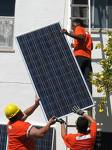Greetings from Beijing.
Where, from my cafe seat near Tiananmen Square, plans to expand solar power in the United States look a lot different than from my office in Northern California — where I am the CEO of one of America’s larger solar power companies.
Many of the measures — and half measures — that we read about every day in American papers are things the Germans and Chinese and Spanish and French decided to do 10 years ago.
They are racing. We are walking.
Germany, for example: Hardly a sunny hot spot — but it has more solar installations than any country in the world. 200 times more than England.
That is because German citizens have been getting 50 to 75 cents per kilowatt hour for the solar power they sell back to the grid. Spain is similar.
Great Britain and France and Ontario and other places throughout the world recently raised their so-called ‘feed in tariffs’ to comparable levels. In Gainseville, Florida, the feed-in tariff is now the highest in the country at 32 cents.
All of a sudden there is an explosion of interest in solar in Gainseville.
In California, we get less than 10 cents. And that is more than most places.
In the United States, we limit not just the price but also the amount of solar energy an owner can sell back to the grid.
So we wait for the day when all the transmission lines are perfect. When the grid is perfect. When all the energy infrastructure is in place.
Meanwhile, we wait for an energy future that may never come.
If we allowed the price to rise, and removed the limits on how much solar energy a farmer or business owner or school or police station could generate, we would see an explosion in demand for solar and other renewables.
That would reduce our dependence on foreign energy and stimulate domestic manufacturing as well.
It’s a two-fer.
That is our best chance of creating solar panel manufacturing jobs in the United States. But it is already very late in the game.
Michael Northrop of the Rockefeller Brothers Fund points out the most of the world’s largest renewable energy manufacturing happens outside the United States. He says:
“Not only are we shipping oil dollars to the Middle East, we are watching our solar, wind, and other renewable energy dollars begin flowing to Asia. … The U.S. needs to decide rapidly whether it wants to own this future or pay for it.”
From my seat in Beijing, where I am travelling the country visiting suppliers for my solar power installation company, it looks as if this decision has already been made.
Tom Rooney is the President and CEO of SPG Solar. He can be reached at www.spgsolar.com
by Editor
